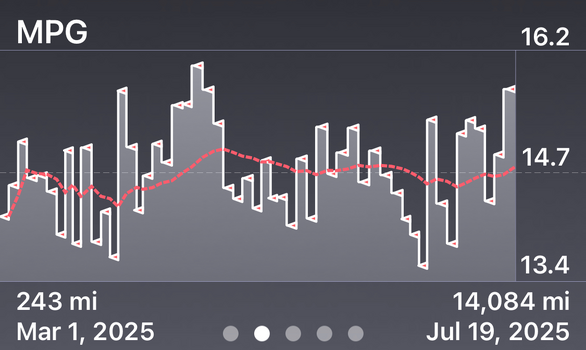Looks like mine, but never below 13.6 mpg.Grenadier: up close and personal
3rj.org
View attachment 7899293
The average gas mileage since new: 13.744 miles per gallon.
The average gas mileage on new tires: 12.387 miles per gallon.
The Grenadier Forum
Register a free account today to become a member! Once signed in, you'll be able to contribute to the community by adding your own topics, posts, and connect with other members through your own private inbox! INEOS Agents, Dealers or Commercial vendors please use the contact us link at the bottom of the page.
-
Guest submit your best shot for a chance to win the December Photo Contest. Photo Contest Click Here
You are using an out of date browser. It may not display this or other websites correctly.
You should upgrade or use an alternative browser.
You should upgrade or use an alternative browser.
What's you're real world MPG (USA)
- Thread starter FlyingTexan
- Start date
Blame West Coast speed limits!Looks like mine, but never below 13.6 mpg.
80 mph (speed limit!) in UT going up I-15 into headwind = 10 mpg.
So I have had some interesting variations in my mileage over the course of the past year and a half of ownership. When I first got my Grenny (say the first 6 months) I would average somewhere around 14.5 MPG. Then when I mounted my 2 Jerry cans on the Bison Gear molle panel (drivers side rear window) my mileage dropped significantly. For the next several months I dropped into the high 12 MPG - low 13 MPG. This seemed awfully dramatic but I chalked it up to the weight and change in aerodynamics.
When winter hit I moved the Jerry Cans into the rear Cargo area. The mileage picked up a bit but more in the high 13 to low 14 MPG. as we moved out of winter and into mid spring I remounted the Jerry Cans to the molle panel. Interestingly enough my gas mileage has returned to the mid 14 MPG territory and in some cases into the 15 MPG.
*All surface road travels with roughly 80% highway at high speeds between 75-80 MPH
**I travel for work and the Grenny is my daily driver. I am in some remote areas (Upstate NY, VT, ME, NH) and there are times where gas stations are few and far between.
When winter hit I moved the Jerry Cans into the rear Cargo area. The mileage picked up a bit but more in the high 13 to low 14 MPG. as we moved out of winter and into mid spring I remounted the Jerry Cans to the molle panel. Interestingly enough my gas mileage has returned to the mid 14 MPG territory and in some cases into the 15 MPG.
*All surface road travels with roughly 80% highway at high speeds between 75-80 MPH
**I travel for work and the Grenny is my daily driver. I am in some remote areas (Upstate NY, VT, ME, NH) and there are times where gas stations are few and far between.
To add to that, I see no real significant difference whether I have my RTT on or not. And It's a Roam Vagabond, so not a little hard shell. I just chalk it up to these things being rolling bricks and enlarging the brick doesn't matter much.

It was a 2 way trip on a UK motorway. I did a 2 way trip over the pennies on UK motorway, so up hill and down each way and it showed 30mpg average. That was around 200 miles.That just isn't possible unless you were going downhill with a tailwind.
Tyres are 40psi
I've always been good at getting high mpg.
Don’t think of skid plates as adding more weight; think of them as aerodynamically “cleaning up” the greasy side. Better mpg ensues!It depends on how I drive it....when we drove from Colorado to Maine we got a whopping 9.6 mpg at times. This had a ton to do with my SPEED (85 to 90 MPH) for long stretches of time with a headwind. When I drove more conservatively around 75 to 80 mph I got about 12 mpg. Aside from the speed (speed kills...MPG...LOL), I get mostly 13 to 14 MPG on good days. Avg 12 to 13 mpg when doing the typical I-25 80 mph to 85 mph w/o being fully loaded to the gills.
In every vehicle I keep my fuel receipts and diligently keep accurate records. In ours, I find that 18.6 mpg shown on the computer works out to 15 mpg or thereabouts.
I do have a 3/4 Leitner rack with Maxtrax at the front of the rack as well as the rear side molle panels. I also have some beefy White Knuckle Off Road sliders that adds a bunch of weight.
Next potential mod for me will be skid plates that will add some additional weight.
960 miles and 13.4 mpg.
The correction factor I use when I am want real time MPG from the computer is to multiply “displayed MPG X .833”. That gets you really close to real-world US MPG and accounts for the Imperial gal which appears to be baked into the trip computer. I have to assume IMP gals also calculate into “remaining range”- but I have not ever done the math there.You may have already discovered this information, but the difference is caused by the IG computer using Imperial Gallons for the calculation instead of US Gallons. Since the Imperial Gallon is larger, the denominator in the calculation is smaller and the MPG higher, than if you use US Gallons for the denominator.
Modifying this seems to be low hanging fruit for some INEOS software engineer. …..While you’re at it give us a CHOICE between MPG(US), MPG(IMP) and L/100 km!
- Local time
- 4:42 PM
- Joined
- Oct 2, 2023
- Messages
- 625
I'm still getting 16-18 @ 55-60 mph on the TDI tuner.
Did you ever notice, the epa mileage is a single number? It’s because there is no variable, you get what you get. If I drive hammer down in manual max rev, I get 2. If I drift downhill in N, I get 80. Does that mean I get 2-80????
If you want to give pertinent data, just post the miles on the odo, and how many gallons you’ve purchased. If you want to be detailed, say, I did “x” and got “y”. But random claims with 20 % variability of guesswork based on a random visual observation of a tip computer are useless.
If you want to give pertinent data, just post the miles on the odo, and how many gallons you’ve purchased. If you want to be detailed, say, I did “x” and got “y”. But random claims with 20 % variability of guesswork based on a random visual observation of a tip computer are useless.
What? No it's not guesswork - it's a range. There is a shit ton of variability and no, it's not useless, nor random visual observations. Mine ranges from 13.4-16.2 over 14,000 miles with an average of 14.7. It's really not that hard of a concept.Did you ever notice, the epa mileage is a single number? It’s because there is no variable, you get what you get. If I drive hammer down in manual max rev, I get 2. If I drift downhill in N, I get 80. Does that mean I get 2-80????
If you want to give pertinent data, just post the miles on the odo, and how many gallons you’ve purchased. If you want to be detailed, say, I did “x” and got “y”. But random claims with 20 % variability of guesswork based on a random visual observation of a tip computer are useless.
Attachments
Metrics are useful if they inform actions. Calculation of fuel economy can perhaps identify a problem with the vehicle or the aggressiveness of your driving. Both are worth knowing about.What? No it's not guesswork - it's a range. There is a shit ton of variability and no, it's not useless, nor random visual observations. Mine ranges from 13.4-16.2 over 14,000 miles with an average of 14.7. It's really not that hard of a concept.
I began to think about mileage when I noticed that the Grenadier calculated long term mpg at 19 - 20, way above the claimed fuel economy. It's hilarious that the Grenadier-calculated value is based on imperial gallons. While the automatically calculated mpg is high, another poster points out that multiplying by 0.8333 or dividing by 1.2 gets you to values more intuitive to Americans, which adjustment is not that hard.
My mileage, manually calculated at the gas pump, is usually about 16 mpg, less in the mountains and occasionally 17 when I am lucky. I have 13,000 miles on the vehicle and, while I travel 70-80 mph on highways, I accelerate gently.
I had the ADAS update two weeks ago. I have about ~1020 miles on the truck. My mileage on the dash said 13.4. After the update a day later the calculation changed to 18.1? Crazy. I still have the speed warning on in the car. I turn it off via "favorites. Does anyone know how to stop the noise once and for all? I went into settings and unlit some stuff, I didn't unlit the Auto-braking, is this why it keeps returning?
Saying you get 13-15 is exactly that, guess work. Unless you give the exact specific environmental and use data with every single datapoint you within the range, so one knows what causes that range, its useless and one has to guess. It also doesn't give anyone a skew.What? No it's not guesswork - it's a range. There is a shit ton of variability and no, it's not useless, nor random visual observations. Mine ranges from 13.4-16.2 over 14,000 miles with an average of 14.7. It's really not that hard of a concept.
Say I live on canton ave in Pittsburgh. It's grade is 37%. A neighbor wants to know how my efficiency as he's debating on a new ride. I can present the information as "I get 3-60" mpg, (A random observation of going up v going down, useless because both happen as an average when you live there), or, I can present it as "I get 9 mpg". Which presentation is an accurate and useful representation of the data? The range data doesn't give you any sort of inkling as to the shape of the curve (skew) and falsely presents the ability to fall within that range depending on other factors than the grade of the hill. The fact of the matter is, if you live on Canton Ave, you're getting 9mpg. Period. There is no "range". Likewise, In Labrats life with the Grenadier, Labrat has gone X miles using Y fuel and achieved XY mpg, and only XY mpg, and, as the past is immutable, that is the only MPG he could have had. There is no range.
That's the reason the EPA only gives the mileage data as X city, and X highway. not x-x city and x-x highway.
Whatever. It's the range of the MPG per tank.Saying you get 13-15 is exactly that, guess work. Unless you give the exact specific environmental and use data with every single datapoint you within the range, so one knows what causes that range, its useless and one has to guess. It also doesn't give anyone a skew.
Say I live on canton ave in Pittsburgh. It's grade is 37%. A neighbor wants to know how my efficiency as he's debating on a new ride. I can present the information as "I get 3-60" mpg, (A random observation of going up v going down, useless because both happen as an average when you live there), or, I can present it as "I get 9 mpg". Which presentation is an accurate and useful representation of the data? The range data doesn't give you any sort of inkling as to the shape of the curve (skew) and falsely presents the ability to fall within that range depending on other factors than the grade of the hill. The fact of the matter is, if you live on Canton Ave, you're getting 9mpg. Period. There is no "range". Likewise, In Labrats life with the Grenadier, Labrat has gone X miles using Y fuel and achieved XY mpg, and only XY mpg, and, as the past is immutable, that is the only MPG he could have had. There is no range.
That's the reason the EPA only gives the mileage data as X city, and X highway. not x-x city and x-x highway.
FFSSaying you get 13-15 is exactly that, guess work. Unless you give the exact specific environmental and use data with every single datapoint you within the range, so one knows what causes that range, its useless and one has to guess. It also doesn't give anyone a skew.
Say I live on canton ave in Pittsburgh. It's grade is 37%. A neighbor wants to know how my efficiency as he's debating on a new ride. I can present the information as "I get 3-60" mpg, (A random observation of going up v going down, useless because both happen as an average when you live there), or, I can present it as "I get 9 mpg". Which presentation is an accurate and useful representation of the data? The range data doesn't give you any sort of inkling as to the shape of the curve (skew) and falsely presents the ability to fall within that range depending on other factors than the grade of the hill. The fact of the matter is, if you live on Canton Ave, you're getting 9mpg. Period. There is no "range". Likewise, In Labrats life with the Grenadier, Labrat has gone X miles using Y fuel and achieved XY mpg, and only XY mpg, and, as the past is immutable, that is the only MPG he could have had. There is no range.
That's the reason the EPA only gives the mileage data as X city, and X highway. not x-x city and x-x highway.
If they use the correct UPDATE for your software it will remove it so that when you set it ONCE....it stays like that until you change it manually. It will not make any sounds due to your speed. The first update did not work though updated a lot of stuff. They told me there was another released that was correct for my vehicle, so they did it again and this time it worked as promised. Am told there are two versions...one for very early 2024...and one for later modely year releases. My dealer is Hendrick Inos Charleston if they need reference for which to use....I had the ADAS update two weeks ago. I have about ~1020 miles on the truck. My mileage on the dash said 13.4. After the update a day later the calculation changed to 18.1? Crazy. I still have the speed warning on in the car. I turn it off via "favorites. Does anyone know how to stop the noise once and for all? I went into settings and unlit some stuff, I didn't unlit the Auto-braking, is this why it keeps returning?
I'm seeing 17.3 mpg driving around LA metro, 230 miles or so on my '24 w/ software update.
Hand calculated or based on the computer? The instrument cluster displays around 2-3MPG greater than actualI'm seeing 17.3 mpg driving around LA metro, 230 miles or so on my '24 w/ software update.
Comp. Good to know, thanks.Hand calculated or based on the computer? The instrument cluster displays around 2-3MPG greater than actual
Similar threads
- Replies
- 2
- Views
- 282
- Replies
- 62
- Views
- 8K




